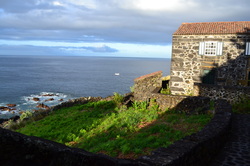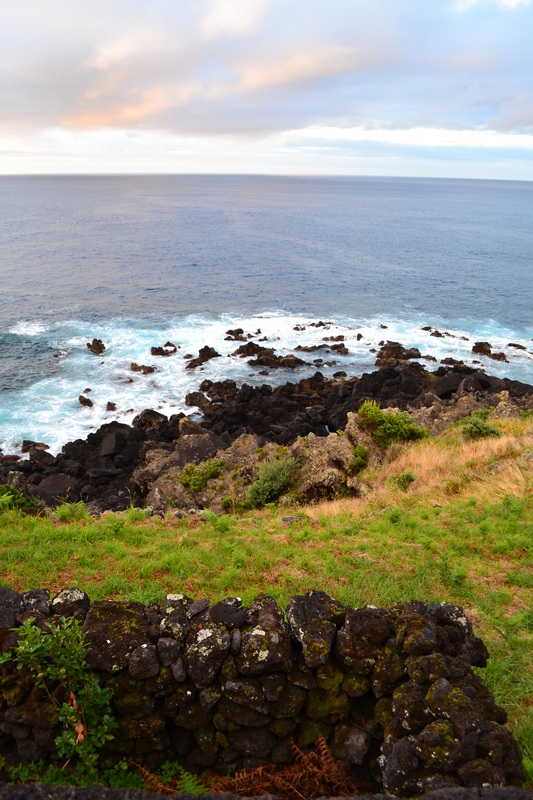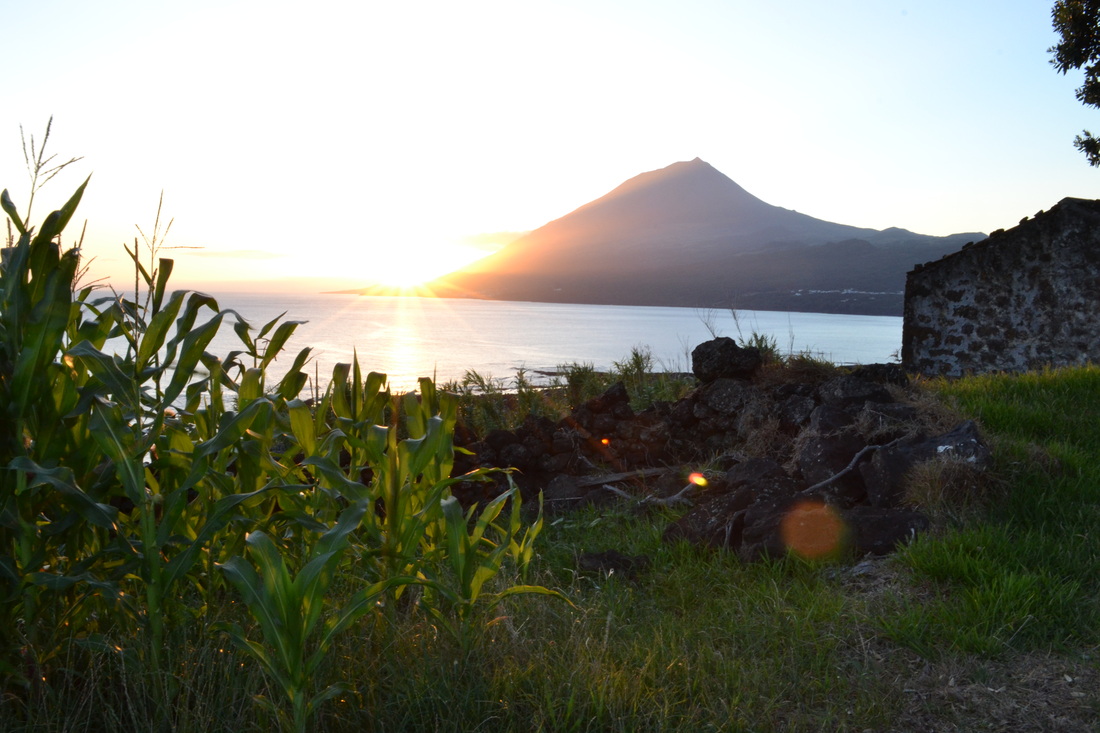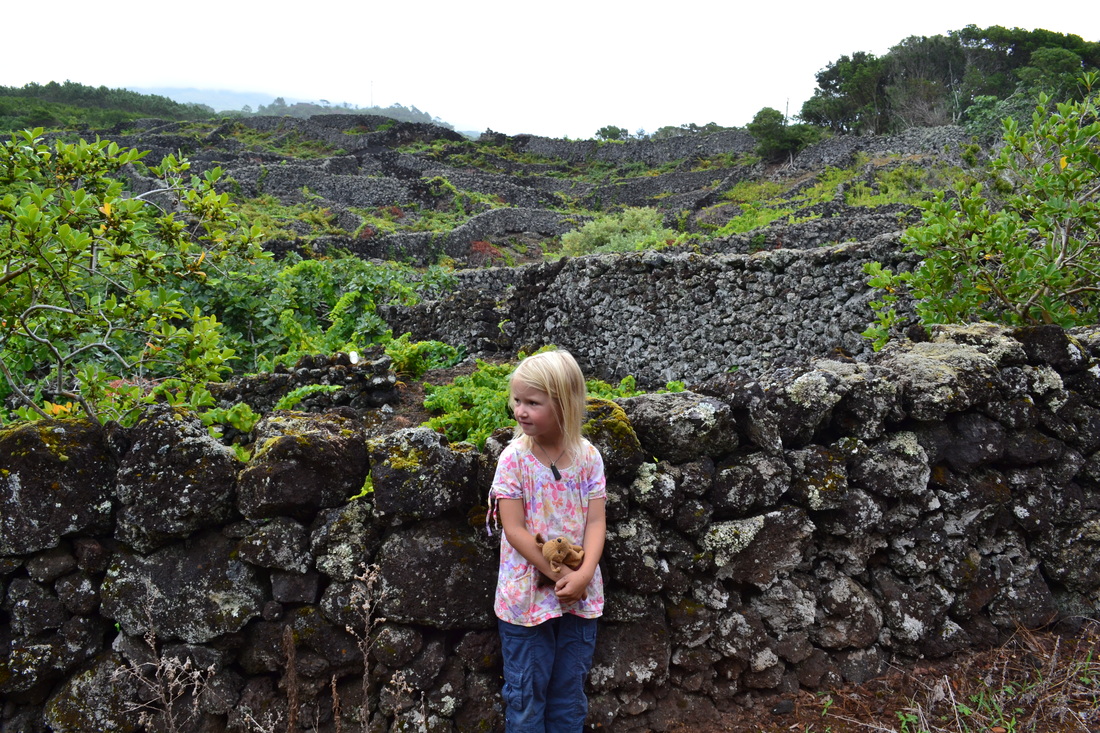 Island of Pico
Island of Pico Vixen left Flores for an overnight trip to the central group of islands in the Azores, specifically to Horta Harbor – one of the main crossroads of the world for voyaging yachts. The wind forecast looked good – northwest 15-20 knots – for the 130 mile trip but I had a feeling the swell would be running high; all night Vixen had strained at her mooring lines from the waves entering the small harbor of Lajes das Flores.
This feeling proved true as we got clear of the protection of the island; it was a nice sailing day but a two-meter swell was running at right angles to Vixen's course chucking her up and down. In addition, there were squalls, up to maybe 30 knots which had Tiffany and me striking the jib and putting a single reef in the mainsail.
Often people ask me what I do day-to-day during an ocean passage. I usually have the feeling of having had a lot to do – of having been “busy” for the whole trip whether it be one day long or thirty. But, if you ask me what I did the whole time I have trouble answering specifically. On this last voyage from Maine I decided to consciously keep track of what I was doing from hour to hour.
Apparently, I spend a lot of time looking at waves. You could call it “keeping watch” but, in fact, there were many times when I could have been down below or busy with some activity but instead I chose to spend hours looking at the waves.
Watching waves is endlessly interesting to me. Although a wave's characteristics in a typical forecast might be reduced to “1.9 meters high from the northwest” in reality there are always mosaics of wave patterns overlayed on the ocean's surface. Usually I can pick out two or three wave patterns other than the prominent wind-driven swell. Traditional Polynesian navigators can pick out many more and will, in fact, triangulate a boat's position by keeping track of subtle wave patterns. Polynesian navigators have even proven that they can detect the reverberation of a wave pattern off of an island 50 or even 100 miles away. These reflective waves are clearly visible from aerial or satellite images but I have found them very difficult to sense from the deck of a boat. Only many decades of serious wave watching can fine tune this ability.
Besides the information-rich patterns of the ocean's waves there is another element which makes for interesting wave watching: the capricious nature of the earth's winds. I can be sitting in Vixen's cockpit reading my book and look up to see waves of a certain tone, say, ominous or aggressive or lazy or gentle. I'll look down for five minutes to read and when I look up again the tone will have changed, often quite dramatically. I imagine this is because the wind – the wave's driver – is seldom perfectly constant. Just as a ferocious squall can come blowing through on an otherwise calm day I've see moments of slick calm for 5 or 10 minutes in the middle of a full gale. What causes these changes I can't say for sure. There must be upwellings and mid-oceanic currents and atmospheric pressure differentials that we can't see which make the ocean the dynamic and unpredictable environment that it is.
On this last trip from Maine we had a few hours of absolute calm. There was still a slight heaving to the ocean's surface but no detectable wind. Even the lightest wisp of a telltale hung limply from the stays. Then I would just get a feeling that there was a breeze. Not a feeling like wind on my face because it was lighter that that but a feeling inside that there was some wind. I think it actually came from my eyes watching the waves; if I looked carefully at the glossy roll of the ocean I could see tiny fissures in its surface – tiny indentations along the backs of the swells. My mind was unconsciously registering this slight pattern as wind and if I focused and looked carefully at the little divots I could actually see from what direction the new wind was coming. And sure enough 5 or 10 minutes later the telltales would lift, a faint breeze would brush my cheek and the new wind would have arrived. An hour later Vixen would be doing 7 knots on a broad reach in a 15-knot southwest wind.
My scariest times on Vixen have been when I haven't been able to see the surface of the waves. It is not unusual on an ocean passage to have nights of true darkness. Nights when you can hold your own hand inches from your face and see only blackness. These are nights with no moon and heavy cloud cover to obliterate any starlight. Sometimes a trickle of phosphorescence still streams off the rudder leaving an eerie luminous path. The most haunting experience for me is to be sitting in Vixen's cockpit and hear a large wave coming towards us – a big crasher thundering through the darkness. As it approaches I can hear that the sound is coming from above head level and for a moment I wonder if Vixen will rise to meet this rogue. Fortunately, Vixen always has lifted her buoyant stern but often not without me getting a full saltwater slap in the face.
On the other hand, some of the most sublime moments on the ocean are in the early morning after a gale when the sea is running high. As the sun breaks above the horizon the low-angled light beams across the waves. If I'm lucky I'll sometimes see one wave cresting higher than the others and a then a blast of sunlight will go shooting through it. The wave's pewter-dull surface transforms, for an instant, into a brilliant translucent prism of turquoise, greens and blinding white froth.
Vixen is now in Horta Harbor. We had a great week over on Pico watching the whaleboat races and staying in our friend Helen's traditional homes. At some point in the next month we will head south to the Canaries.




 RSS Feed
RSS Feed
